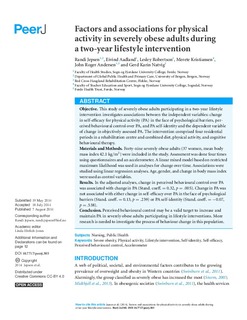| dc.contributor.author | Jepsen, Randi | |
| dc.contributor.author | Aadland, Eivind | |
| dc.contributor.author | Robertson, Lesley | |
| dc.contributor.author | Kristiansen, Merete | |
| dc.contributor.author | Andersen, John Roger | |
| dc.contributor.author | Natvig, Gerd Karin | |
| dc.date.accessioned | 2014-10-02T12:12:04Z | |
| dc.date.accessioned | 2014-10-03T11:34:42Z | |
| dc.date.available | 2014-10-02T12:12:04Z | |
| dc.date.available | 2014-10-03T11:34:42Z | |
| dc.date.issued | 2014 | |
| dc.identifier.citation | Jepsen et al. (2014), Factors and associations for physical activity in severely obese adults during a two-year lifestyle intervention. PeerJ 2:e505; DOI 10.7717/peerj.505 | nb_NO |
| dc.identifier.issn | 2167-8359 | |
| dc.identifier.uri | http://hdl.handle.net/11250/222936 | |
| dc.description.abstract | Objective. This study of severely obese adults participating in a two-year lifestyle
intervention investigates associations between the independent variables: change
in self-efficacy for physical activity (PA) in the face of psychological barriers, perceived
behavioural control over PA, and PA self-identity and the dependent variable
of change in objectively assessed PA. The intervention comprised four residential
periods in a rehabilitation centre and combined diet, physical activity, and cognitive
behavioural therapy.
Materials andMethods. Forty-nine severely obese adults (37 women, mean body
mass index 42.1 kg/m2) were included in the study. Assessment was done four times
using questionnaires and an accelerometer. A linear mixed model based on restricted
maximum likelihood was used in analyses for change over time. Associations were
studied using linear regression analyses. Age, gender, and change in bodymass index
were used as control variables.
Results. In the adjusted analyses, change in perceived behavioural control over PA
was associated with change in PA (Stand. coeff. = 0.32, p = .005). Change in PA was
not associated with either change in self-efficacy over PA in the face of psychological
barriers (Stand. coeff. = 0.13, p = .259) or PA self-identity (Stand. coeff. = −0.07,
p = .538).
Conclusion. Perceived behavioural control may be a valid target to increase and
maintain PA in severely obese adults participating in lifestyle interventions. More
research is needed to investigate the process of behaviour change in this population. | nb_NO |
| dc.language.iso | eng | nb_NO |
| dc.publisher | PeerJ | nb_NO |
| dc.relation.uri | https://peerj.com/articles/505/ | |
| dc.subject | Nursing | nb_NO |
| dc.subject | Public health | nb_NO |
| dc.subject | Severe obesity | nb_NO |
| dc.subject | Physical activity | nb_NO |
| dc.subject | Lifestyle intervention | nb_NO |
| dc.subject | Self-identity | nb_NO |
| dc.subject | Self-efficacy | nb_NO |
| dc.subject | Perceived behavioural control | nb_NO |
| dc.subject | Accelerometer | nb_NO |
| dc.title | Factors and associations for physical activity in severely obese adults during a two-year lifestyle intervention | nb_NO |
| dc.type | Journal article | nb_NO |
| dc.type | Peer reviewed | nb_NO |
| dc.date.updated | 2014-10-02T12:12:04Z | |
| dc.subject.nsi | VDP::Medisinske fag: 700::Helsefag: 800::Samfunnsmedisin, sosialmedisin: 801 | nb_NO |
| dc.subject.nsi | VDP::Midical sciences: 700::Health sciences: 800::Community medicine, social medicine: 801 | nb_NO |
| dc.source.journal | PeerJ | nb_NO |
| dc.identifier.doi | 10.7717/peerj.505 | |
| dc.identifier.cristin | 1145717 | |
